#Tartan Films
Text

did i just spend an hour searching through old newspaper articles about thatcher + the miners strike + christianity + left-wing scottish politics just to cut them all up to make a stained glass window for the cover of one of my fics that about three people have read. yes because i am normal and sane
#i heart making covers / posters for my fics as if they are real books / films#because it’s not as if i have you know. an entire final thesis i should be writing instead#also yeah that is the macdonald tartan in the background i thought it was cute
27 notes
·
View notes
Text

Gene Kelly's embrace in Brigadoon (1954)
11 notes
·
View notes
Text

Eva Podzimková 🇨🇿
Still from A Soul to Redeem (2017)
je_podzimkova
#eva podzimkova#actress#czech#brunette#brown eyes#tartan apron#white shirt#puff sleeve shirt#violin#beauty#stunning#classy#film still#a soul to redeem#poisonsome
6 notes
·
View notes
Text

#35mm#self#35mm film#lift#elevator#wrestling#tartan#Glasgow#selfie on film#selfieonfilm#sof#mirror#mirror selfie#selfie#l&r#Ryan
2 notes
·
View notes
Text
caught between a rock (young peter capaldi awooga awooga) and a hard place (he looks like my fucking dad at that age)
#it's the Being Scottish bc i am also not far off from looking like angus flint but STILL#also the tartan he wears in that film is so similar to ours that i got jumpscared a little gjfhshh#diary#also im aware that the metaphor is being used wrong. i dont care
7 notes
·
View notes
Text

photo by Emily <3
#sour surprise#35mm#film#friends#college#jacket#varsity#letterman jacket#colourful#kawaii#harajuku#gloomy bears#Paul frank#plushies#teddy bears#tartan skirt#Japanese fashion#vintage
4 notes
·
View notes
Text

Charlie & Peace Lily by Lili Marcovich
5 notes
·
View notes
Text
Good Omens has shown us, among other things...
-Crowley pointing the paintball gun at Aziraphale and giving the office workers miraculous escapes from death *before* it showed us The Blitz, Part 2's Bullet Catch that shows us what he was referencing to Aziraphale by doing so
-Aziraphale's love of human magic and his vanishing coins act and Crowley grumbling about all of it *before* it showed us "the farthing has vanished!" and The Marvelous Mr. Fell and his "volunteer assistant" on stage in 1941
-The 1862 breakup *before* the 1827 scene that gives context for their traumas that led to the breakup
-The sexy lunch in 2008 *before* the ox rib date that started it-- all the way back in 2500 B.C..
-Crowley telling Aziraphale about his night dealing with the antichrist baby: "Well, not, delivered-delivered, just... handed it over" *before* professional midwife/cobbler Bildad the Shuite "birthing" Job and Sitis some "new" kids
-Crowley, alone, forced into the start of Armageddon by delivering the antichrist in a picnic basket *before* 1967, in which Aziraphale dreams of a world they could get to before they run out of time in which they could go on a picnic together
-Aziraphale looking to the side Crowley always comes up on when he hears the miracle sound in the sushi restaurant in 1.01 *before* we even know that Crowley always comes up in the same way from various scenes teaching us this
-Aziraphale's tartan obsession *before* its origin story, which is the date in Edinburgh in 1827 wherein he became spirituality Scottish and thought he lost Crowley and after which he adopted the tartan as a thing related to the two of them and never stopped wearing it. See also: showed us 1967 and the tartan thermos *before* explaining to us that the tartan isn't just something Aziraphale likes but is something with meaning to the two of them together as a pair
-Crowley rambling drunkenly about bananas, fish and gorillas in the bookshop *before* his and Aziraphale's 'banana fish gorilla shoelace with a dash of nutmeg' conversation over wine in 1941, showing us that he was drunkenly remembering in a scene in S1 a romantic scene in their history that we didn't know then and wouldn't know until S2
-Crowley & Aziraphale dining at The Ritz in 2008 in 1.01 *before* we even know that was The Ritz or why it matters that it was, which they don't tell us until the final, romantic moments of S1
-Crowley obsessively growing a large, lush, overhanging canopy of plants in his apartment *before* telling us he's got a thing for vavoom-y erotic gazing and kissing under the shelter of canopies the likes of which have never been seen in a Richard Curtis film
So, my dear, dear loves... explain to me why I'm not going to be adding to this list next season:
-that heartbreaking 2.06 kiss *before* the first one they had a bazillion years ago?
1K notes
·
View notes
Note
hi neil! how come scotland looked cartoon-ish with the tartan hills and nessie when aziraphale drove up here? is it how aziraphale perceives scotland?
It was a tribute to Powell and Pressburger's glorious film I Know Where I'm Going.

2K notes
·
View notes
Text
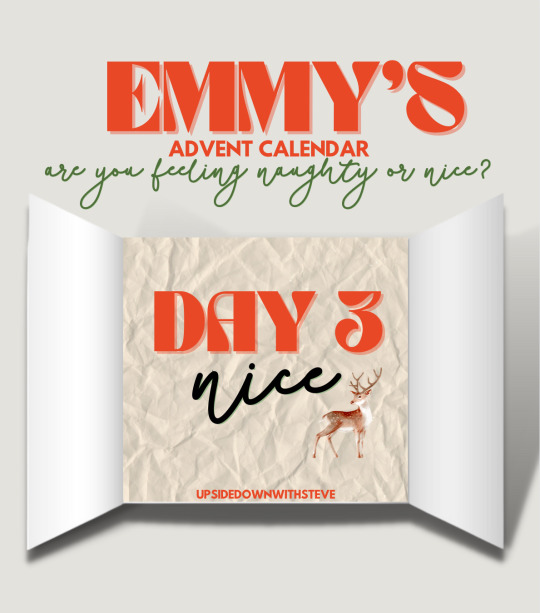
DAY THREE: Steve Harrington x fem!reader
When Steve was three years old, his parents would take him to Hawkins country club to spend Christmas Eve in the dining hall. There were other families, all just as wealthy, mothers glittering in jewels, fathers smoking cigars, kids his age who were wearing miniature bow ties and tartan dresses, all frills and bright smiles.
The year after, they spent Christmas Day there too, all the food and wine they could ever want already prepared and offered on silver platters for them. Steve was allowed to bring one new toy, a plastic speed boat that had miniature figurines with deck shoes and sunglasses. The year after that, they stayed at the country club overnight and his mom declared there was no need to put up a tree at home.
When Steve was ten, he was deemed old enough to sit at a different table from his parents in the dining hall, sitting with children he didn’t know as they all tried to work out which fork to use with course number five. He sat on Santa’s lap, a man that looked uncomfortably familiar underneath his white beard, but he smelled like whiskey and he gave Steve a jigsaw puzzle of a cowboy with a white horse.
Steve hated jigsaws.
At fifteen, Steve stopped going to the country club. He waved goodbye to his parents on Christmas Eve, his mom’s lipstick print on his cheek, the house dark and quiet. No tree, no lights, just a movie and a takeaway pizza.
It was fine.
Steve didn’t mind it. Not really, not that much.
Then he met you.
You with your dumb, woollen jumpers and love for oversized hot chocolates, smelling like candy canes and somehow always having glitter on your cheeks. You with your love of old movies, the black and white Christmas films that his VHS player had a hard time not chewing up. You with your bright eyes, always excited and pleased to see him, arriving on his doorstep on Christmas Eve with a bag full of treats, oversized marshmallows and a pair of slippers that you never even wore. You who tucked yourself into Steve’s life and Steve’s side like you’d always been there, ready to create your own festive traditions with him.
You bought him too many presents, every year, crinkling your nose when he fussed and kissing him stupid when he handed you a pile in return. You spent the whole year listening to him, finding out more about the boy than he thought anyone would ever care to do. The new music he liked, the movie he missed at the cinema, now on video. His favourite chocolate, wrapped in shiny gold paper, the kind of sweater he liked, soft and not scratchy from that store at the mall he always liked to gaze at.
You tied everything up with a bow, made eggnog and gingerbread cookies in his otherwise empty kitchen, bare feet on the cold tiles because you’d left your slippers in his room, but it didn’t matter. You’d curl beside Steve on the sofa, tucking your freezing toes beneath his thighs.
Steve didn’t mind. Not really. Not in the slightest.
Steve didn’t mind at all.
#steve harrington#steve harrington x reader#steve harrington x you#steve harrington x y/n#steve harrington fic#steve harrington fluff#steve harrington imagine#steve harrington fanfic#Steve Harrington fanfiction#Steve Harrington oneshot#Steve Harrington blurb#EAC23
362 notes
·
View notes
Text
Good Omens season 2 referencing Powell & Pressburger films


Crowley's angel hair is modeled after Kim Hunter's hair as June in A Matter of Life and Death (1946).

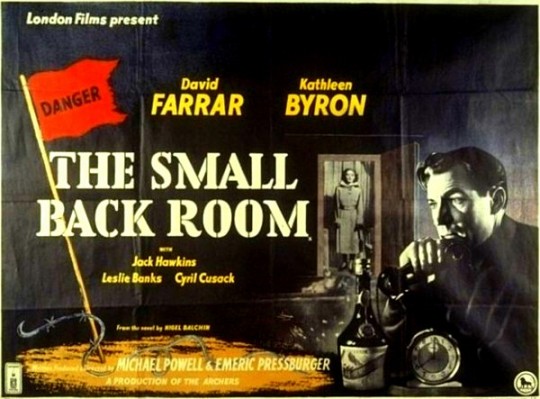
Maggie's shop is called The Small Back Room in reference to 1949's The Small Back Room.
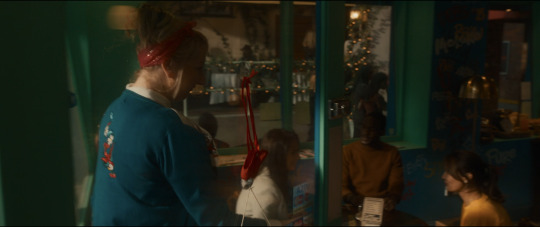
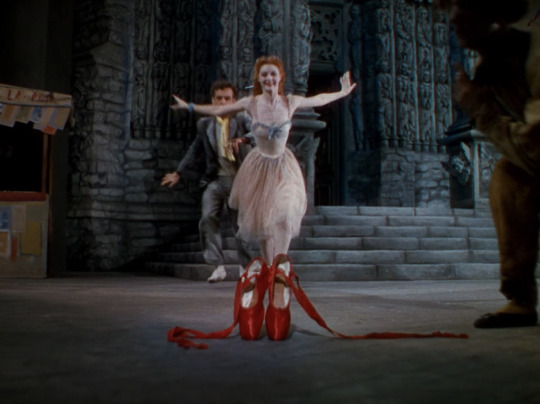
The red ballet shoes on the door of Give Me Coffee or Give Me Death are a nod to The Red Shoes (1948).
(Note : the klaxons sounding in Heaven at the end of episode 1 are said to be a nod to the alarm bells in The Other World in A Matter of Life and Death. Personally, I don't think they sound at all alike; they are only similar in both being alarms. Plus, it's an audio reference, which I don't have the skill or patience to include here. But it's there!)
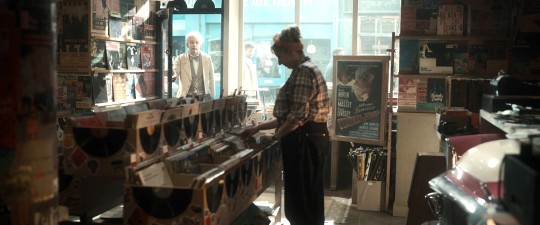
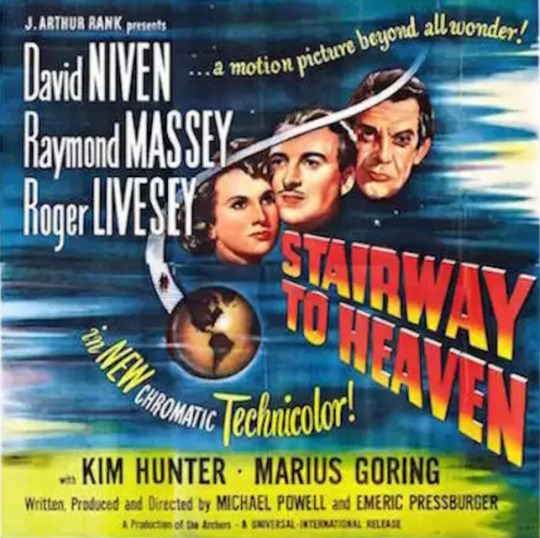
In The Small Back Room, Maggie has a poster for the film Stairway to Heaven displayed. A Matter of Life and Death was released under this title in the US.

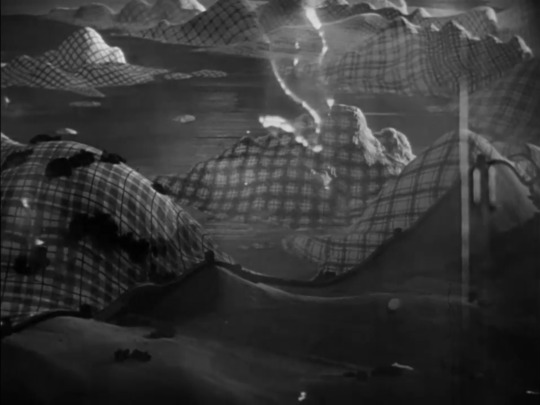
The tartan hills welcoming Aziraphale to Scotland are a reference to the tartan hills welcoming Joan to Scotland in I Know Where I'm Going! (1945). And of course, the third episode is itself titled "I Know Where I'm Going."

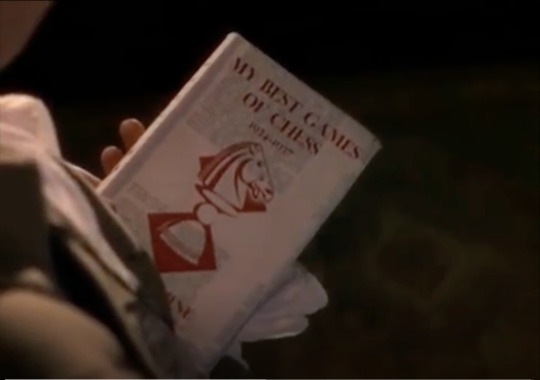
Jim drops the book My Best Games of Chess, 1924-1937, by Alexander Alekhine, onto a table in the bookshop repeatedly as he is discovering how gravity works. This book is featured prominently in A Matter of Life and Death.
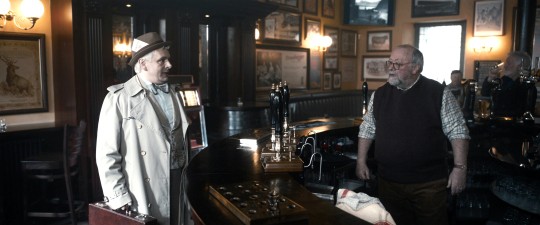

When Aziraphale enters The Resurrectionist pub in Edinburgh, I Know Where I'm Going! is playing on both televisions (I'm pretty sure I found the right scene to match this screenshot). You can also make out the name 'Pressburger' on one of the posters in this screenshot, but we'll get to that later. . .

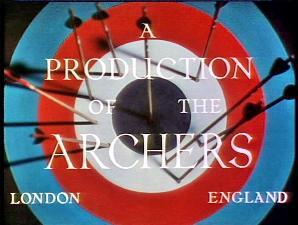
The family name on the mausoleum where Aziraphale and Crowley hide out with Elspeth and Wee Morag is Archers. It's never clearly seen in the show, but it can be seen in this BTS photo of the model used for Crowley's embiggening. The Archers was the name of Powell and Pressburger's production company. The interior of the tomb and the urns outside the full-size set also reference the Archers, and Powell & Pressburger individually.
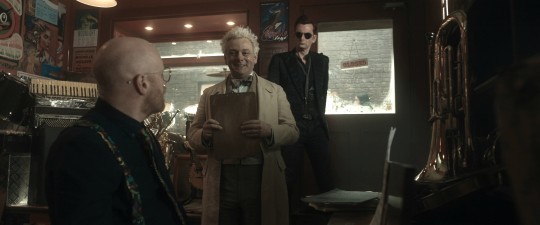

In Mr. Arnold's record shop, one of the posters on the wall is for a UK music tour; either the band or the tour is titled Met By Moonlight. This is referencing Ill Met By Moonlight (1957), the final film Powell & Pressburger made together. (I personally think this one is a reach, as the title of the film is a line from A Midsummer Night's Dream and thus not really clockable to the outside viewer as a direct Archers reference, but apparently the intent was there so we're counting it!)
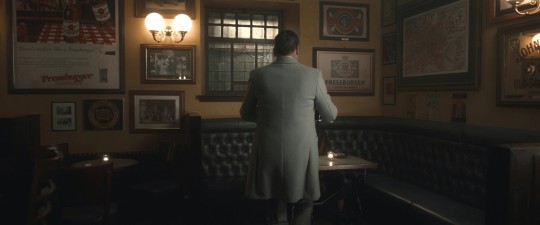
The Pressburger posters are more clearly visible during the Gabriel and Beelzebub rendezvous scene in The Resurrectionists pub. We can see they advertise 'Pressburger Scottish Lager,' which is of course a nod to Emeric Pressburger himself. (Unclear if Michael Powell has his own label that we just don't get a clear view of. . .)
-- -- -- -- --
I clocked a couple of these myself, but they are all referenced in the X-Ray trivia on the Prime Video player. Would love to know if anyone has clocked anymore that aren't divulged. . .
#as a side note : please watch a matter of life and death#it is exquisite as a film and also very relevant to gomens interests#it's on youtube!#good omens#powell and pressburger#the archers#a matter of life and death#the small back room#the red shoes#i know where i'm going#ill met by moonlight
312 notes
·
View notes
Text
A recap of the panel with Peter Anderson Studio at The Ineffable Con 4
- Season 2 opening titles are a direct continuation of the end of Season 1 opening titles.
- All of it is only possible because of Neil Gaiman and Douglas Mackinnon. Peter Anderson says it’s because of “their brillance as creatives and their celebration of each person that they work with. They have a kind of respect for and celebrate, but they also collaborate in the best way possible.”
- Gabriel is hidden in every scene of the title sequence.
- The duck referenced on Mr. Brown’s newspaper (ep. 2) appears in the title sequence too (duck playing the accordion at the front of the stage).
- The indication cards (London, Present Day, Hell, etc) are made for real and then filmed.
- The Scotland hills were made with paper maché. The green and blue tartan is actually a Mackinnon tartan in reference to Douglas Mackinnon.
- The spider and Nazi fly were created for real and then filmed.
- The nebulae we can see at the beginning were chosen because people could relate to them.
- Peter Anderson confirms that there are hints for Season 3 in the Season 2 title sequences.
- It took about 6 months to make the opening titles.
- The symbols in heaven are actual language that can be decoded.
- The planet being born when Aziraphale and Crowley are dancing is just a planet.
- The Adam headstone refers to Adam and Eve.
- The names behind the chairs in the magic show are important. They all connect to different episodes and characters.
@neil-gaiman @theineffablecon
#good omens#good omens 2#good omens 3#Peter Anderson studio#neil gaiman#the ineffable con#TIC 4#it’s ineffable angel#Good Omens News
372 notes
·
View notes
Text

Jan Bartek - AncientPages.com - New scientific research has revealed a piece of tartan found in a peat bog in Glen Affric around forty years ago can be dated to circa 1500-1600 AD, making it the oldest known surviving specimen of true tartan in Scotland.
The Scottish Tartans Authority commissioned Dye Analysis and Radiocarbon testing on the woolen textile to prove its age.
Scotland's Oldest Tartan On Display For The First Time!
Glen Affric tartan - Scotland's oldest-known true tartan discovered by The Scottish Tartans Authority to go on display for the first time at V&A Dundee's Tartan exhibition.
Credit: Alan Richardson Pix-AR
The first investigation was dye analysis carried out by analytical scientists from National Museums Scotland. Using high-resolution digital microscopy, four colors were visually identified for dye analysis: green, brown, and possibly red and yellow.
The dye analysis confirmed the use of indigo/woad in the green but was inconclusive for the other colors, probably due to the dyestuff degradation state. However, no artificial or semi-synthetic dyestuffs were involved in making the tartan, which pointed to a date of pre-1750s.
Further clarification on the age of the tartan involved radiocarbon testing at the SUERC Radiocarbon Laboratory in East Kilbride. The process involved washing out all the peat staining, which would have otherwise contaminated the carbon content of the textile.
The Radiocarbon testing results identified a broad date range between 1500 and 1655 AD, with the period between 1500 and 1600 AD the most probable. This makes it the oldest-known piece of true tartan found in Scotland – the Falkirk ‘tartan,’ dating from the early third century AD, is actually a simpler check pattern woven using undyed yarns.
The Glen Affric tartan, which measures around 55cm by 43cm, is now on display for the first time at V&A Dundee’s Tartan exhibition.
by TaboolaSponsored Links
The piece will be the oldest exhibit among more than 300 objects. The exhibition examines tartan’s universal and enduring appeal through iconic and everyday examples of fashion, architecture, graphic and product design, photography, furniture, glass and ceramics, film, performance, and art.
“The testing process has taken nearly six months, but the effort was well worth it, and we are thrilled with the results!
In Scotland, surviving examples of old textiles are rare as the soil is not conducive to their survival. As the piece was buried in peat, meaning it had no exposure to air and was therefore preserved.
The tartan has several colors with multiple stripes of different sizes, and so it corresponds to what people would think of as a true tartan.
“Although we can theorize about the Glen Affric tartan, it’s important that we don’t construct history around it. Although Clan Chisholm controlled that area, we cannot attribute the tartan to them as we don’t know who owned it.
“The potential presence of red, a color that Gaels considered a status symbol, is interesting because of the more rustic nature of the cloth. This piece is not something you would associate with a king or someone of high status; it is more likely to be an outdoor working garment," Peter MacDonald, Head of Research and Collections at The Scottish Tartans Authorit said.
Scotland's Oldest Tartan On Display For The First Time!
New scientific research has revealed a piece of tartan found in a peat bog in Glen Affric, Scotland around forty years ago can be dated to circa 1500-1600 AD, making it the oldest known surviving specimen of true tartan in Scotland. Credit: Credit: Alan Richardson Pix-AR
“The Glen Affric tartan is clearly a piece of national and historical significance. It is likely to date to the reign of James V, Mary Queen of Scots, or James VI/I. “There is no other known surviving piece of tartan from this period of this age. It's a remarkable discovery and deserves national attention and preservation. “It also deserves to be seen and we’re delighted that it is to be included in the Tartan exhibition at V&A Dundee,” John McLeish, Chair of The Scottish Tartans Authority, said.
“We knew The Scottish Tartans Authority had a tremendous archive of material and we initially approached them to ask if they knew of any examples of 'proto-tartans' that could be loaned to the exhibition.
I'm delighted the exhibition has encouraged further exploration into this plaid portion and very thankful for The Scottish Tartans Authority's backing and support in uncovering such a historic find.
To be able to exhibit the Glen Affric tartan is immensely important in understanding the textile traditions from which modern tartan derives, and I'm sure visitors will appreciate seeing this on public display for the very first time," James Wylie, curator at V&A Dundee said.
Tartan at V&A Dundee opens on Saturday, 1 April, until 14 January 2024.
Written by Jan Bartek - AncientPages.com Staff Writer
Source: Facebook
Source: AncientPages.com
239 notes
·
View notes
Text

2 notes
·
View notes
Text
I Know Where I'm Going
Aziraphale's Edinburgh Journey: Part 5
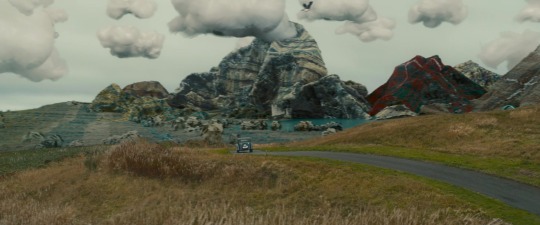
Episode 3 of S2 is named after a black-and-white 1945 Powell and Pressburger film, which is in turn named after an old Scottish folk song. It's a delightful film, which I'll discuss further below the cut, that strides headlong into the theme of fate vs free will, among other things.
This is the last major piece we need to tie things together, after starting this journey with The Clue in Episode 2, which lead Aziraphale to make the journey to Edinburgh in the first place.
Fate vs Free Will
I Know Where I'm Going, both the film and S2E3, is about not ending up where you expected to be, so this how Aziraphale went expecting to find the answer to one question, but found the answer to an unexpected question instead. So part of the problem we have is that while we end up getting the answers to two questions, one expected and one unexpected, I feel people really aren't recognizing the questions that raise them in the first place.
Not making sense? Let me describe the film.
Joan is a confident young (25yo) lady on her way to the (fictitious) Ilse of Kiloran to marry a rich older industrialist. This involves a journey by train then several ferries to the ultimate destination. However she gets stuck on the Isle of Mull, the penultimate stop, as the weather turns, and has to stay the night, then several days, as a bad gale blows.
She meets a fellow traveller, Torquill McNeil, a naval officer home on leave, who invites her up to one of the local mansions. Joan meets some of the delightful and slightly eccentric locals (the pack of goofy, soft wolf hounds of the Lady of the house, Catriona Potts, are a highlight of the film, imo) including a retired colonel who's into falconry who keeps going on about a lost golden eagle that he's training. (The eagle is a metaphor for Torquill, it turns out.)
We find out Torquill is actually the Laird of Kiloran, and he is renting out Kiloran to Joan's husband-to-be for money while he's off in the navy seeing the world. Torquill knows all the locals, and the locals know him, and they are all kind of bound together as one big happy family, in a way.
The next morning Torquill takes Joan to the hotel in another village to talk to her fiance via radio, as they still can't get to the other island. The fiance (who we never see) recommends visiting another house nearby. She does, and we find out they are also rich from new money, and care nothing about the locals and the local environment. And this is where we start learning there is a bit of divide between the old and the new, the rural out door life that is connected to the land, and the new wealth that cuts itself off from its surroundings and other people. And Joan is going to be a part of that - in her dream on the train, the same dream that gives us the tartan clad hills, she marries a corporation, not a person - so impersonal!

Joan is desperate to get across to Kiloran (she knows where she's going! She thinks...) After repeatedly bumping into Torquill over the next couple of days and it becoming evident there are feelings growing between them, she bribes a young local boatman to take her across to her fiance and expected marriage on Kiloran to escape this, even though the gale is still blowing strong. Torquill finds out at the last minute, and jumps into the boat with them. They get caught in a squall, and the motor cuts out. The tide drags them towards the infamous local whirlpool, and they only just escape due to Torquill's expertise.
Joan is chastened when they return to safety. That was the point of not risking the crossing in the gale in the first place, explains Torquill. They could have sent a rescue boat out if they got into trouble, but it puts more than just the rescuers at risk, it puts their families at risk, and then that extends to the whole island. Doesn't she see how the whole island is interconnected? She finally realizes how selfish she has been.
The next day dawns brightly, and the gale has finally blown out - the sea is a calm and a ferry crossing will be no trouble today. The colonel finally catches up with his golden eagle, and brings it home to roost.
Joan and Torquill say their farewells on the road, and there's a Great Big Kiss before they part and go their separate ways.
Torquill walks past the ruined castle that he is fated to be cursed if he enters as Laird of Kiloran. But he decides to risk it, and he goes in and explores the ruins, and we hear the whole story of the curse and finds that it isn't such a bad curse after all - in a metaphorical way! The next thing he hears is bagpipes - it's Joan returning up the road with the pipers that were supposed to be at her wedding. She has decided she wasn't going where she thought she was going after all and has come back to be with Torquill, her new love.
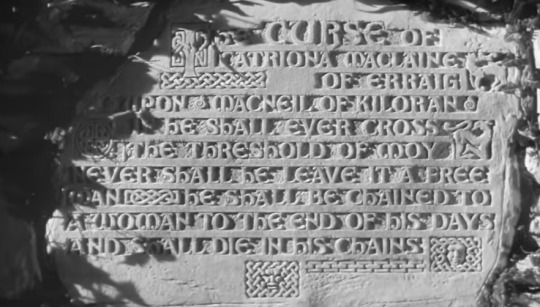
That's the basics of the story, but if you would like to watch it, I would recommend you do, as there is a lot more in it than that.
(I did watch "A Matter of Life and Death/Stairway to Heaven" before finishing this post, seeing as the book that features in it also appears in S2xE3, which is the main episode around the trip to Edinburgh, but more in relation to Gabriel's situation I think. It also deals with a character trying to escape their intended fate, but they do so by attending a formal trial and pleading their case. Other ops have reviewed the film here and here if you want to find out a bit more. I wasn't as impressed with that film, sorry to say, but I will probably watch it again to reflect on certain features and points in it relevant to GO, there is a lot. And to work out which minor character a very young Sir Richard Attenborough was playing!)
Lunatic Behaviour and Lethal Traps
Some ops have pointed out that Elspeth and Wee Morag act as parallel characters to Crowley and Aziraphale. While some would argue there are various ways to interpret this, the music indicates that Elspeth aligns with Crowley and Wee Morag with Aziraphale.

Elspeth is the one trying hard to engineer the pair's escape from the poverty trap they are in, even if it is by nefarious means. Wee Morag is the one scandalised by Elspeth's illicit actions, and concerned about doing right by Heaven. Crowley takes up Elspeth's side of the argument against Aziraphale, that its not as easy to escape poverty as one thinks (i.e. just working hard will fix things) but he also tries to warn Wee Morag that things don't work the way she thinks they do in the afterlife either.
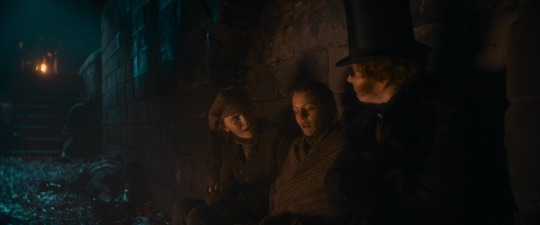
So what's the price one pays for going down the path of body snatching as an escape from poverty? You have to get past the lethal traps of the grave guns that have been set, by not tripping the wires. And again, its the wealthy privileged ones that have the advantage.
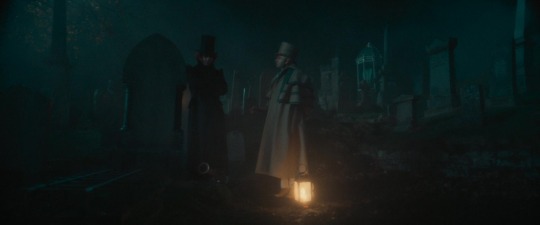
Acting in haste was a disaster. They got split up, never to see one another again. One more body may have got them out of short term trouble, but what about the long term?
Escape is a nice dream, but a harsh reality.
Elspeth was going to use the laudanum as another form of easy escape, until Crowley prevented it, then acted as a daemonium ex machina to assist her in escaping properly good, using Aziraphale's money, as that was really the only way she was going to escape for good.*
Joan tried to escape Torquill in I Know Where I'm Going, but only cast herself and her companions into danger. If she had been more patient and less selfish, she might have had everything she wanted without suffering on the way. But that wouldn't have made as good a story then, would it? And she wouldn't have gotten to know Torquill and fallen for him, either.
If Aziraphale ran away to Alpha Centauri with Crowley, like Crowley had been urging in the present, would they be free? The inference is its unlikely, that they wouldn't be able to escape their own "poverty trap," the alarms would be raised, and the trouble they caused would be too deep to pull themselves out of. Luck hasn't been on their side so far.
The View from Above
By now we should be alert to characters trying to avoid their fate, or perhaps ending up in places they weren't intending to. Fate has a weird way of biting you on the backside, as the trope goes.

Giant Crowley did end up somewhere he wasn't intending to be, and perhaps accidentally ended up playing God and deciding Elspeth's fate. There are mentions of angels as tall as mountains, or tall as the sky in the Bible, so him ordering Aziraphale to give all his money to Elspeth while looking down at them shouldn't really be out of place for those familiar with the book. Crowley also took Elspeth's fate into his own hands when he snatched the laudanum away from her and drank it down, an action akin to absolving her of her sins.
Aziraphale also tried to change Elspeth's and Wee Morag's fate, by changing his mind about the morality of the body snatching. That didn't end up the way he hoped or expected, either.
Mr Dalrymple was of aware of two fates he could meet, he just didn't know which one it would be at the time he was s talking to Aziraphale and Crowley.
DALRYMPLE: I either end up with a knighthood or condemned as a resurrectionist and hanging from a rope.
Sadly, we find out through Aziraphale reading the pamphlet he picked up outside the pub that it was along the lines of the second one - he might not have been actually condemned for a crime, but he condemned his own conscience and then his soul.
If you would like a contrast to this, come back to S1xE2, where we approach a young Newton Pulsifer in his bedroom, about to short out the electrical works for his whole neighbourhood yet again. God is narrating at this point, and the camera view pans down from the sky...and bumps with a visible jolt and audible noise into the window frame of his bedroom. (I wasn't able to find a GIF for this.)
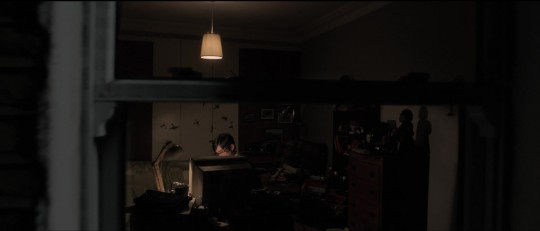
Newt is a Crowley-parallel, they are both on the side of free will and choosing one's destiny. This is not a place for God, the decider of Fate, to trespass. There will be no crossing of this threshold, Frances!
I would just like to take a step back here to Part 4: Judgement Day, if I may, and reconsider this view of the missing cross in the statue of Gabriel's arms:
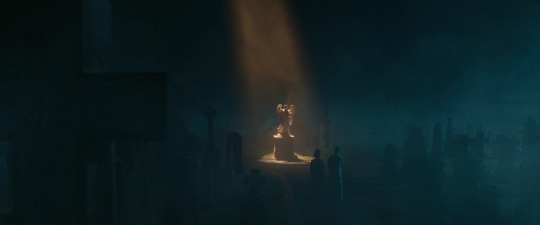
This is the only point of view that we don't see the cross from. It's still seen from between Gabriel's and Beelzebub's shoulders, and Crowley stills see it in 1826, so it's not invisible to demons.

So I would like to ask, could the missing cross view be God's point of view?
The viewpoint is similar to the one in the Job minisode, as seen from where Aziraphale and Crowley are witnessing Job listen to the Almighty speak to him.
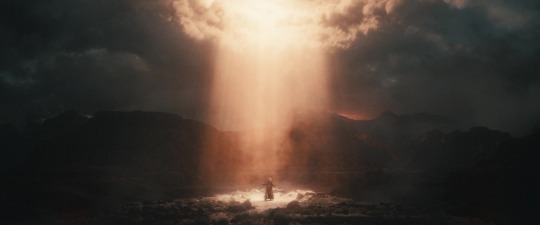
So, perhaps if God isn't seeing the cross, they aren't the one who has so-called Ineffable Plans for the Second Coming in mind.
Yeah, so there's the Great Plan, and the Ineffable Plan, but are they the same plan...and who is pushing so hard for the Great Plan to come to completion, then? Not Gabriel or Beelzebub, that's for sure.

66 Goat Gate
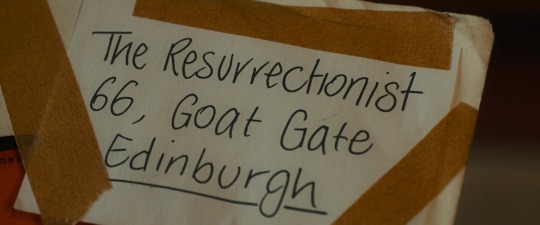
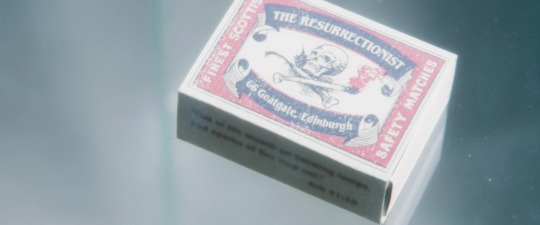
Just before we attempt to wrap things up, we should have a look at the address on the Clue, but it doesn't really tell us anything we don't already know.
We know the address of the pub in Edinburgh appears in two places, once on the record single Maggie gives to Aziraphale and once on the matchbox that held the fly. There is a difference in the way they are written, with an comma on the record, and also Goat Gate written as two words, whereas it is one word on the matchbox.
Gate was old name for a road, so one interpretation could be that it was hinting at a demon road, or an underground road (demons live in Hell, which is underground, and demons are also associated with goats) and that ties in with the resurrection and Judgement Day theme we have going on, and perhaps should alert us to the presence of at least one demon being involved with Gabriel. On the other side, a goatgate is a relatively modern term for someone who talks a load of shite, so to speak. If we use Strong's Concordance to add the 66 to it, it becomes a wild or fierce mouth. Which kind of suits the Leviathan referenced in the verse from the Book of Job. The first version then looks like a wild underground road to Hell on the way to the Second Coming (the Harrowing of Hell in the Passion, anyone?) Don't forget the number 6 is associated with Hell as well.
Piecing the Elephant Together
There is a famous parable about a group of blind men meeting an elephant for the first time. They each go up and touch a different part of the huge beast, and subsequently give a different description for each part of it, but collectively they can't describe it properly as a whole.
That's kind of how we tend to look at Good Omens - its such a huge, complicated beast of a story, with each of us picking out one strand to analyze that might be our specialty, but we don't necessarily have all the other pieces nearby to aid our understanding as to why it was placed there or what it is doing and how that aids the purpose of the story.
To sum things up:
Aziraphale's trip to Edinburgh in the Bentley is a parallel to Crowley and Muriel going to Heaven together to find out about Gabriel, but Aziraphale is actually going to Edinburgh to find out about Beelzebub (he just doesn't realize it.)
Gabriel was there in the pub, and met with a "Mason" in a regular black-coloured suit that the barman was used to seeing Masons dressed in, because he noted that Gabriel's light grey suit was different.
We are shown many clues to the looming Second Coming
We see parallel scenes to S1, which at the same time sets upparallels for S3, which are about starting Armageddon. Again.
We also gain a lot of interlinked information for other parts of S2, and parts that link up with S1 and maybe S3, such as:
Aziraphale's main parallel in S2 is Beelzebub, with Maggie a parallel blend of the two of them.
Mr Dalrymple shows us that something needs to be cut out to save the innocent, but we also need to learn what it is before we can do that.
Elspeth and Wee Morag show us that running away is not as simple an option as it seems, its more a fatal trap than anything.
The Masonic symbols appearing in S2 remind us that life and death is a cycle, but also sometimes thoughts need to be turned around.
Aziraphale thought he knew where he was going, but he didn't really; fate gave him answers that he wasn't expecting. Did he ask the right questions?
There is not just a single purpose for Aziraphale to go to Edinburgh, there were several.
I also think Aziraphale didn't have enough time to stop and think about it, or talk it through with Crowley. They both had to leap from one thing to another until it was too late.
I was going to finish this off with that quote about history repeating itself until you learn from your mistakes or something, but then I found this one:
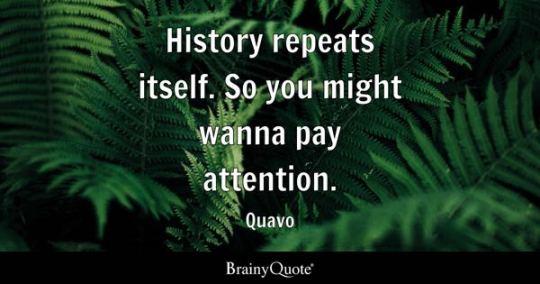
*Slaps this beast on the backside to move it along so it can go roam free in the wilderness.*
*This is actually something that is well researched but not well known, and is called the Success Paradox. You can watch a good explanation of it by one of my favourite science vloggers Veratisium here. Women are probably most aware of it intuitively, because of inherit sexism in our patriarchal society, but it also exists in the attitude "if you work hard you can make anything happen." What most people don't realize is how much luck factors into their success. Lucky they were born into a wealthy family. Lucky they met the right person on the right day. Lucky they were chosen over another etc. Before you argue otherwise, do stop and think about it.
The other posts in this series can be found here:
Part 1: Detective Aziraphale
Part 2: Aziraphale-Beelzebub Parallels
Part 3: Stocktaking in the Basement
Part 4: Judgement Day
#good omens#good omens 2#good omens meta#i know where i'm going#fate vs free will#powell and pressburger
55 notes
·
View notes
Text
Witnessing Greatness

Thinking about the most recent episode of Doctor Who, I find myself reminded of Roger Corman, who died last month. Corman was a producer and director of b-movies and television. He was also beloved by industry titans due to his work ethic and ingenuity as a filmmaker. What made Corman so unique is how he dealt with limitations. If an aspect of one of his films was lacking, he made up for it in other departments. If the effects were bad, the script had to be great. If the acting was hammy, he’d make sure the music gave it strength. Instead of spreading everything thin, he knew that giving a little bit more attention to individual elements would make for an overall better experience. If you’re not firing on all cylinders, make sure the ones that do are firing brightly.
“Rogue,” is an episode with many bright shining points, lighting up the sky of Regency Era Britain. But lost within that light are a few flickering bulbs that could stand to be turned a bit tighter. However, it’s not as though we’re poking around in the dark. Without a doubt, the brightest star in the Whoniverse at the moment is Ncuti Gatwa. In a stand-out performance from a series of stand-out performances, Gatwa has really outdone himself this week and I can’t wait to talk about it. The folks at Bad Wolf Studios have refused to spread things thin, but no story is perfect. For as much as I enjoyed this week’s episode, I didn’t have to reach far to find problems. But when I’m smiling this much, it’s harder to care.
It’s funny how a week ago I said I didn’t like fan theories and then promptly made one. Just as promptly, I am now abandoning that theory. After the trailer for next week’s episode, I no longer think Susan Twist is the Rani. I officially don’t know what I think. I kind of love that. I have seen the rumours of Susan Twist being Sutekh. Maybe the Doctor is in the Land of Fiction. The name S Triad is an anagram of the word TARDIS. Perhaps she’s the original owner of the TARDIS coming to retrieve it. The point is, she could be anyone, and I am not all that worried about it. Why that feels important is that I was often full of dread waiting for Chibnall’s next big reveal. I didn’t look forward to the ways in which he might next waste a concept by not properly exploring it. So being in a place where I am game for whatever feels zen.

Having two new writers this week was a major draw for me. I’ve seen what both Davies and Moffat can do, the good and the bad. This is the first time all season where I felt like we were truly wandering into the unknown. I did watch Loki season one, so I was familiar with Kate Herron’s work, but not as a writer. I was even less familiar with Briony Redman. But like I said, I’m game for whatever. The pair bring a metatextual reading to the Regency Era drama that fits Doctor Who’s brand of camp. I was reminded of Kate Beaton’s satirical comics from her “Hark! A Vagrant” series. “Rogue,” acts as a sort of love-letter to Jane Austen, so it’s only appropriate that they treat it with a playful touch. The Doctor and Ruby aren’t just visiting Bath in 1813, they’re cosplaying Bridgerton. But they’re not the only anachronistic party goers. This bash is about to go to the birds.
Leading up to this episode, an article in Doctor Who Magazine had given us random lines of dialogue from each story, including this one. However, the line “Psychic earrings. Choreography beamed into your motor system. Tap twice to choose your moves. It's like instant Strictly!” left me a bit nervous. We were fresh off of “The Devil’s Chord,” and part of me was wondering if they weren’t suddenly turning Doctor Who into a variety show. I’m joking a little, but I was rather relieved when the line turned out to be about dancing at the Duchess’ ball. The Doctor and Ruby are dressed to the nines in their period appropriate clothing. I love the idea of the Doctor wearing more from his wardrobe as it’s always been fun in the past. Tom Baker’s tartan tam o’ shanter in “Terror of the Zygons,” is one of his most iconic costumes. Ncuti said in an interview that he wanted his costume to make him look like he owned land. It’s a brilliant image to depict when you consider the Regency Era was merely four years away from the abolition of slavery in Britain.

The Regency Era also brought with it a change in men’s attire. Dandies like Beau Brummell popularised a look of comfort and wealth while simultaneously streamlining much of the frills from 18th century fashion. It’s funny to look at the ruffles of a dandy’s attire and consider it anything other than flamboyant, but it was a considerable shift toward more conservative styles. While women’s fashion continued to evolve, men’s fashion stagnated a bit. A standard had been established and you can still see its influence today with the basic suit and tie combo. No wonder the Doctors often dress like variations on Edwardian fashion.
The opulence of the period led to a lot of scandalising and gossip, which has given us centuries of great drama. While I’ve never read “Emma,” I have seen “Clueless.” I’ve never watched Bridgerton, but I can still get into the costuming and pomp. Basically you don’t need to be a fan of the genre to know the tropes. It was a nice change of pace that it was Ruby’s love for a tv show that puts things into motion. The Doctor and Ruby are tourists as much as the Chuldur, but with far less deadly consequences. Both groups are there to experience the emotional highs of the time, but the Chuldur don’t care who they hurt in order to do it. This of course is why Rogue, a bounty hunter, has also crashed the party.

You’ll be pleased to know I actually remembered to watch “Doctor Who Unleashed,” this week. Partly because I had some questions, but mostly because I wanted to hear them talk about the costumes and make-up effects. Davies mentioned that the season hadn’t yet had its baddie in a mask trying to take over the world, which I love that he considers. If you read my review of “The Witchfinders,” you may recall how much I appreciated the Morax being scenery chewing people in latex makeup. There’s something essentially Doctor Who about bug eyed monsters (sorry Sydney) and there’s something very RTD when those monsters have animal heads. Davies is now confirmed as a furry, I’m calling it.
The Chuldur share their appearance with birds, something we don’t often see in Doctor Who. I’m trying to recall bird villains from the show and I am coming up a bit short. There were the Shansheeth in the Sarah Jane Adventures, those bird people on Varos, that heavenly chicken from “The Time Monster,” and the Black Guardian’s hat. Considering all of the reptiles we get, I’m surprised we’ve gotten so few birds. If you also watched the Unleashed episode, you may have noticed that they digitally changed the bird version of Emily’s beak from black to orange. It’s the Vinvocci’s green faces from “The End of Time,” all over again! What’s funny is that this change in Emily’s beak gives her something of a penguin appearance. It’s not exactly the shapeshifting penguin I was hoping for, but I digress.

Speaking of shapeshifting, I rather enjoyed the Chuldur’s unique method of doing so. If you recall, when the Duchess spots her servant out in the garden, the bird form of the servant is played by the same actor as the servant. It’s not until she takes the form of the Duchess that her bird form also takes on the resemblance of Indira Varma. You don’t usually see that and I admire them for making two versions of the same makeup, if nothing else. Doctor Who has had its share of shapeshifters, so it’s nice to see them changing up the formula a bit. Unfortunately for the Duchess, this isn’t a Zygon type of body snatching where you have to keep the person you’re copying alive.

Ruby’s psychic earrings are doing a treat until they begin picking up interference from Rogue’s tech. A lot of people have mentioned that this episode seems to borrow a lot from “An Empty Child,” and so it’s only appropriate that the Doctor does a scan for alien tech. The source of the interference directs the Doctor toward the balcony where Rogue stands brooding. Meanwhile, the Chuldur version of Lord Barton has taken a liking to Ruby. The Duchess, still human at this point, attempts to introduce them, but Ruby is not impressed by the pompous dandy, referring to him as Lord Stilton. As Ruby strops away she notices a painting of Susan Twist’s character as an old matron. The Duchess refers to her as “the Duke’s late mother,” whose eyes still follow her around the room in judgement.

The Duchess takes her leave to the garden where she meets her fate with the Chuldur masquerading as her servant. We get a bit more of a look at what exactly the Chuldur do when they take over your body. What’s left of the duchess is little more than a desiccated husk. Meanwhile, in the study, Ruby has stumbled upon a rather intimate moment between Lord Barton and Emily. The bookcase obscuring her from the two frames them like a television screen. Ruby is unable to look away from the real life Bridgerton scene playing out in front of her. The Lord tells Emily that he will not marry her which would leave her ruined, but he is compelled by her nonetheless. However, before they can kiss, Ruby knocks a pile of books onto her head causing a disturbance. I rather loved this moment for Millie Gibson. It’s rare that women get to be portrayed as clumsy and that book definitely bonked her on the head. A great bit of physical comedy.

The Lord storms out of the room leaving Emily and Ruby to talk. Removed from the framing of the bookshelf, Ruby finds her compassion once more and comforts Emily. After all, Lord Barton was being a bit of an ass toward her. Emily is amused by Ruby’s modern sensibilities and lack of finery. You could tell this scene was written by two women as they actually take the time to let them have this moment. Meanwhile, the Doctor and Rogue take a stroll through the garden in order to size one another up. There’s a flirtatious energy between the two but a wary tension underlies the conversation. The Doctor muses about the stars, but on a terrestrial level. It’s not until he finds the Duchess’ shoe and then the rest of her that he gives away that he is not of this world. Rogue sees the Doctor’s sonic screwdriver and begins to suspect the Doctor is a Chuldur in disguise. The two confront one another as the culprit, but Rogue has the bigger gun.

Still comparing sizes, the Doctor and Rogue compare ships like they were Ten and Eleven comparing sonic screwdrivers. Speaking of sonic screwdrivers, it feels appropriate that the Doctor’s sonic would match his outfit. That’s so Fifteen. He’s a fashionable Doctor, so of course he would accessorise. It’s like they made his wardrobe and accessories with cosplay in mind. Rogue’s costume is also noteworthy. People have drawn comparisons between Rogue and Jack Harkness and it’s not difficult to understand. His long coat draws parallels to that of Jacks and he even mentions assembling cabinets in regards to the sonic. But what’s equally interesting is how Rogue’s gun resembles the type of handgun you would see in a Regency Era duel. Its barrel resembles that of a blunderbuss. He’s either deep undercover, or he’s got a thing for cosplay himself.
Rogue doesn’t get a lot of time for character development, but they do give him a few little moments, mostly through environmental storytelling. He has a striking birdlike ship fit for a heroic rogue, but inside it’s dirty and depressing. Possibly most telling on Rogue’s ship are the set of orange dice on his table. Rogue gets his name from Dungeons and Dragons, but beyond being a geek, these dice could tell us more about his personality. We learn that Rogue has lost someone, perhaps these dice belonged to them. Perhaps he is unable to move the dice from that spot because he didn’t leave them there. We also learn later that Rogue isn’t a very strong roleplayer. He’s quieter and more thoughtful in his improvisation. Perhaps his staged tryst was the first time anyone has asked him to roleplay since losing his partner. Either way, Jonathan Groff plays it with a vulnerable subtlety, and I loved it.

Speaking of loved it, we have now reached the portion of this article where I gush over Ncuti Gatwa. Now, I need to preface this by reminding you all that I have always been pro-Ncuti. I adored his portrayal of Eric Effiong in Sex Education. I never doubted for a second that he could pull it off. However, it wasn’t until this episode that his Doctor finally crystalised for me. We’ve seen that his Doctor could be flirtatious and fun, but we hadn’t yet seen the way in which he could use that to do Doctory things. We’ve had hot Doctors, but we’ve never had a Doctor who was so effortlessly hot. He’s hot in the same way the Second Doctor was bumbling, as in it’s almost a distraction from what he’s actually doing. It actually makes him slightly terrifying.
Even as his Doctor is standing in a trap, he’s able to use his charm to buy time. Also, once again the Doctor is stepping onto things that can kill him. An odd recurring theme. He maintains an air of authority even in the face of danger and that is so the Doctor. When the Doctor finds Rogue’s music playlist I think I may have melted. How could anyone incinerate such a beautiful person? How could you not want to dance right along with him? As much as I loved this scene and the meta reference to Astrid Perth, it does also buckle a bit under itself. First of all, wouldn’t the Doctor knowing an Earth song like “Can’t Get You Out of My Head,” make you question whether he was a Chuldur? Sure, they know Bridgerton, but it would be enough to give me pause. Furthermore, I’m not sure how seeing the Doctor’s many faces would cause you to not think he’s a shapeshifter. Kind of odd that one other face means shapeshifter but eighteen other faces don’t. Wait, did I say eighteen?

When I had first watched this episode, I didn’t immediately recognise Richard E Grant as the mysterious extra face in the lineup of past Doctors. We now have three extra faces in the form of Jodie Whittaker, Jo Martin, and David Tennant (again), but this extra Doctor wasn’t registering for me. At first I thought he was the Valeyard, and then I thought he looked a bit like Jim Broadbent, which is ironic considering “The Curse of Fatal Death.” It wasn’t until I got online afterward and saw people saying Richard E Grant that I could see it. I wasn’t even 100% convinced it was him, but I’ve heard they actually took new footage of Grant for that scene, so I guess it’s him. The more interesting question is which him is he? Is this the Shalka Doctor or the Fatal Death Doctor? Maybe he’s both. Maybe he’s neither. This wouldn’t be the first time they’ve given us retroactive Doctors. Moffat gave us the War Doctor to great effect. But despite a strong performance from Jo Martin, Chibnall did a piss poor job of establishing the Fugitive Doctor as a character. I’d love to get excited for this mystery incarnation, but I’m taking a Tim Gunn stance in the meantime- “Make it work.”
With Rogue now on his side, the Doctor takes him to his TARDIS so they can recalibrate his triform transporter to be non-lethal. Recently in an interview, Ncuti Gatwa mentioned he had gotten onto his agent about playing someone like the Doctor or Willy Wonka. It felt a bit like wish fulfilment for his Doctor to sing “Pure Imagination,” to Rogue as they entered the TARDIS. I really loved Jonathan Groff’s slow growing infatuation with the Doctor. I’m a big fan of “Mindhunter,” but it’s a very heavy show, so it was fun to see him in a more playful role. In many ways, Rogue feels like a bit of River Song and a bit of Jack Harkness. He’s something of a reboot and remix at the same time. I don’t doubt we will see him again, which would be a nice chance to give him some much needed character development, but for the time being, we’ve been given enough to work with.

The Doctor and Rogue’s plan is to draw the Chuldur to them by exploiting their love for drama and scandal. What better way to whip people into a frenzy in 1813 Britain than for two men to share a passionate dance together? Besties, I’ll be real, I was grinning from ear to ear. Watching Gatwa and Groff dance was very exciting. I’ve seen people complain that the Doctor and Rogue’s romance felt rushed compared to the “slow burn,” of Yaz and Thirteen. Slow burn is a funny way of saying “non-existent for two seasons.” And I would much rather see two men share a passionate kiss than two women share a passionate ice cream. What’s wild is that I’m not usually the kind of person who likes the Doctor to have romantic relationships. They managed without them for 26 seasons. However, due to Ncuti’s emotional availability, it works for me. I can buy that his time with Donna might have left him more open to romance. Furthermore, this is the antithesis of queerbaiting. Ice cream is not a payoff.

The Doctor ends the dance by staging an argument with Rogue and calling him a cad. But Rogue doesn’t respond in turn with the same volatile energy. There’s a hesitation on his end that feels personal. As I mentioned before, perhaps this is him working up the courage to roleplay again. Perhaps his lost partner was more the avid roleplayer between the two of them. Or perhaps Rogue simply has a softer approach. What I loved is that his marriage proposal felt equally as shocking, but in a more emotional manner. It even feels like it takes the Doctor by surprise. There’s a moment where it actually feels like a real proposal. The Doctor says he can’t and you almost believe he considered it. Or maybe the Doctor can’t even pretend to say yes because of his marriage with River song. If he undoes their wedding maybe it can revert us back to hot air balloon cars, Winston Churchill, and pterodactyls.

Not to be left out, Millie Gibson has gotten a lot of time to shine in this story as well. She does a fair bit of choreography, but there is one bit of her choreography of which I was a bit disappointed. After learning that Ruby is from the future, Emily reveals herself to be a Chuldur, and she wants to cosplay as Ruby next. However, Ruby’s psychic earrings come with a battle mode, which complicates things for the feathered fiend. My disappointment however, stems from the fact that they kind of phone in the fight choreography. They went through the trouble of hiring Bridgerton’s choreographer, Jack Murphy, for the dance sequences, but the fighting felt like a second thought. It could have been really cute to see Ruby do some “Crouching Tiger Hidden Dragon,” moves, but instead she clobbers her with a book. A bit underwhelming. Still a fun idea, though.

The Doctor and Rogue abscond to the garden where they are pursued by the Chuldur who reveal their numbers to be greater than anticipated. As baddies go, the Chuldur were little more than hand wringing monsters foaming at the mouth for a bit of mayhem, but I liked that about them. The way they speak to one another reminded me a lot of the Slitheen. The last time we saw Indira Varma in the Whoniverse, she was playing Suzie Costello, the best part of Torchwood. Here she chews scenery with a zest befitting her brilliant makeup. The only time that I felt they went a bit too far with the Chuldur is when they call what they’re doing “cosplaying,” as it felt a bit too on the nose. Otherwise, I loved the idea of evil birds going around and messing up planets all too satiate a dangerous appetite for excitement.

The Doctor sees Ruby acting as though a Chuldur has taken her form and it brings out the fury of the Time Lord. I wouldn’t be the first and I won’t be the last to point out the parallels between this and “The Family of Blood,” wherein the Doctor has some long term punishment in mind for the bad guys. Unfortunately, it also feels like a case of writers giving the Doctor weird morality again. Rogue wants to send the Chuldur to the incinerator, but the Doctor wants to send them to a dimension where they can live out the rest of their lives somewhere where they can’t hurt anyone. How is that any different from what the Weeping Angels do? It’s “Arachnids in the UK,” all over again. When the Doctor expresses happiness that the Chuldur will suffer for a long time, it begs the question- as compared to what? I’m fine with the Doctor losing his temper and going too far, but what about his plan actually changed other than his attitude about it? He was always planning on sending them into a dimension where they would suffer for 600 odd years. A line of dialogue or two could have fixed that.
The Chuldur’s big finale is a wedding between Barton and Ruby followed by a light bit of mass murder, but the Doctor has other plans. The Doctor’s objection to the marriage reminded me a lot of Tom Baker. I could easily hear Tom saying that line about it being hard to hear things through those heavy doors. Gatwa has that bizarre alien charm that feels correct. However, neither the Chuldur or the Doctor know the entire story as neither side knows Ruby is still Ruby. So when the Doctor traps the Chuldur in the triform transporter, he’s also dooming Ruby to the same fate.

I’ve seen some confusion as to how the transporter actually works, but I think I can piece together enough to understand it. They had calibrated the transporter to trap up to six humanoids. When Ruby is first trapped, there are five humanoids in the trap. Rogue throws Emily into the trap bringing the count up to six. We’ve established that the Doctor was able to throw his psychic paper from inside the trap, so things can leave its field. My thinking is that as Rogue pushes Ruby out from the field, he overloads it with seven humanoids giving Ruby just enough give to fall out of the trap. What got a bit confusing is why didn’t Ruby just step out of her shoes? If you can throw psychic paper, then it’s not trapped by the field. Therefore, her shoes would be the only thing molecularly bonded to the field. They could even say the shapeshifters can’t step out of their shoes because they’re actually part of their bodies. But then we couldn't get the big sacrifice at the end.

The aspect of this that I found harder to follow was why Rogue would sacrifice himself in the first place. Sure he and the Doctor have chemistry and there could be a romance brewing, but he barely knows the guy. Perhaps he couldn’t stomach the idea of watching what happened to him happen to someone else. It was a chance to stop the sort of thing he was previously powerless to prevent. I could buy that well enough, but it barely felt earned. However, it fits the tone of the rest of the episode which was one of over the top romance and drama, so I digress. Around here, fun is king and fun I had. It didn’t matter that I didn’t fully understand people’s motivations. There’s plenty of time for that in the future.
The episode ends with the Doctor sending Rogues ship to orbit the moon until it can be retrieved again (or until the moon hatches like an egg, whichever comes first). He wants to move on, but Ruby won't let him until he takes a moment to feel his feelings. This is classic Doctor/companion stuff. The Doctor has always benefited from having humans around and I am glad they took a moment to reestablish that. The Doctor pulls out Rogue's ring from the proposal and slides it onto his pinky finger. Fans of Amy and Rory will recall that rings can be used to find lost lovers, so there's a seed of hope there. It was a fitting end to an emotional and exciting episode. I got to watch the Doctor and Ruby do Regency Era dances to covers of Lady Gaga and Billie Eilish. I got to see Indira Varma hunt people while dressed as a bird. This wasn’t just my favourite episode of the season, it may be one of my favourite episodes ever.
________________________________________
Before I go, I wanted to apologise for how long this article took me to write. I’ve been dealing with some pretty heavy depression as of late, and it’s been hard to write these last couple of reviews. Even though I enjoyed both episodes quite a bit, it’s been a struggle. Despite episodes dropping at midnight on Saturday now, I don’t usually get around to writing until Sunday or Monday. But I didn’t get any good work done on this article until Monday evening. These articles are actually very therapeutic for me. It feels like a lifeline to the outside world. You may not think it, but I read every comment and every hashtag. I appreciate them all. Thank you for taking the time to read my stuff. It means a lot.
#Doctor Who#Rogue#Briony Redman#Kate Herron#Ncuti Gatwa#Fifteenth Doctor#Ruby Sunday#Millie Gibson#Jonathan Groff#Indira Varma#The Duchess#Chuldur#Regency Era#TARDIS#BBC#Season 1#Russell T Davies#RTD#RTD2#review#timeagainreviews
42 notes
·
View notes